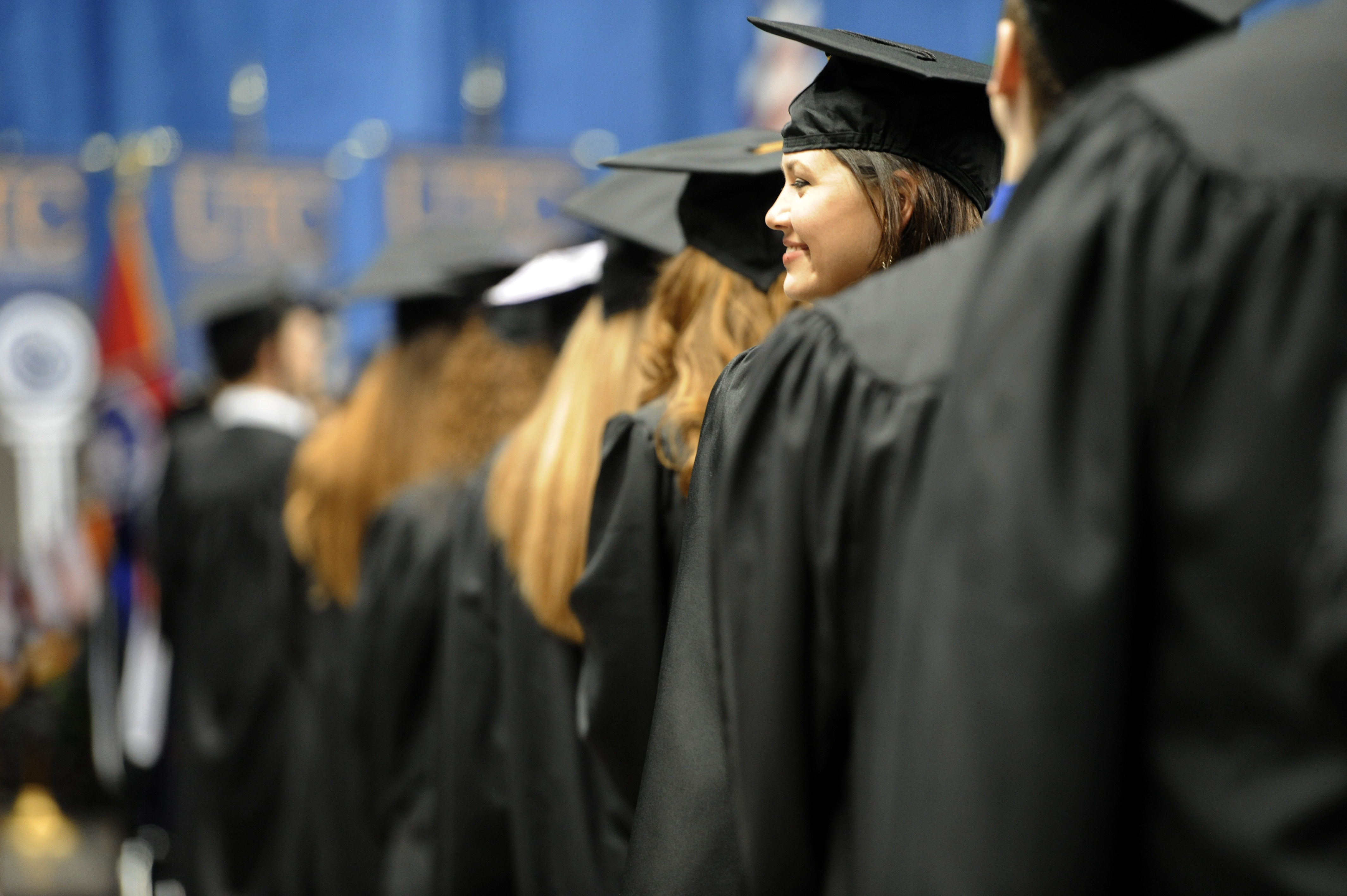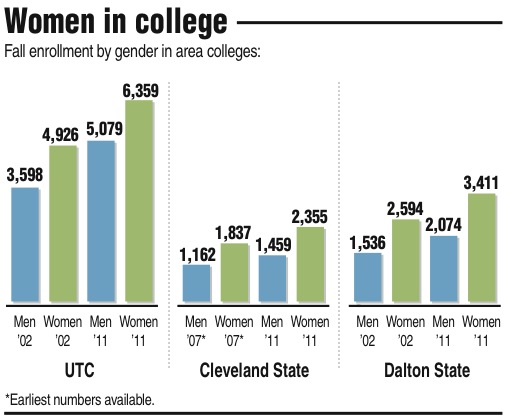FAST FACT
Nationwide, while nearly 28 percent of women had received a bachelor's degree by age 24, only 19 percent of men had done so in 2009-10.Source: U.S. Bureau of Labor Statistics
Over the last 30 years, women have gone from enrolling in college in greater numbers than men to earning more bachelor's degrees to earning the majority of master's and doctoral degrees.
More recently, women are making headway in what traditionally have been considered male-dominated disciplines such as biology.
"Twenty to 30 years ago, biology was mainly male," said Andresse St. Rose, senior researcher for the American Association of University Women. "Today women earn the majority of bachelor's and master's and about half of the [doctoral] degrees in biology."
Women also have begun to close the gap in fields such as business and math, but they still lag in areas including physics and computer science, St. Rose said.
And the pay gap remains an issue, she said.
Tracy Smith, 43, went back to college in 2010 after her production job with La-Z-Boy disappeared. She saw it as an opportunity to go to college, which she had never been able to do because she went into factory work straight out of high school.
So she enrolled in the industrial technology program with a concentration in construction at Cleveland State Community College and hopes to work in making housing more energy efficient.
"It's the future," she said.
She's the only female in many of her classes, but she said that doesn't bother her.
"It just makes me want to work harder," said Smith, a Dunlap, Tenn., resident with a 3.6 grade-point average. "I'm a widow with a 10-year-old child. I want to make her proud and let her know she can do whatever she wants to do."
In 2009, two-thirds of people ages 40 to 49 enrolled in college nationwide were women, but not all the growth can be attributed to women like Smith, who are the breadwinners of their families and are returning to college to get a better job.
In 2010, 28 percent of women received a bachelor's degree by the age of 24, compared with only 19 percent of men, U.S. Bureau of Labor Statistics released this month show.
Both men and women are getting college degrees, St. Rose said. The difference is that women are getting them at a faster rate.
ECONOMICS
Much goes back to economics.
"Over time, everyone knows it's become harder to support a family on one salary," said St. Rose. "The idea of men being the breadwinners of the family is long gone."
During a recession, many institutions, especially community colleges, see an increase in enrollment because people realize that education helps in finding employment, she said, and women are nearly half of the workforce.
Since 1970, the percentage of women with a college degree in the workforce has tripled from 11 to 36 percent, according to the Bureau of Labor Statistics.
Stephanie Bellar got her doctorate in philosophy in 1986 and has been teaching for 27 years, most of those at the University of Tennessee at Chattanooga. In that time, she has seen more women move into academic majors and jobs that once were the domain of men.
"There has been a change in the number of women receiving Ph.D.s in political science; it has increased," she said. "And we increasingly see women in university presidency positions [and] at different levels of administration."
Still, academia is like the rest of the labor force, she said. There has been some progress, but work needs to be done.
STEM FIELDS
Although women still make up the larger share of the college enrollment and workforce in traditionally female-dominated fields such as education and social work, the number pursuing professions in the sciences is increasing steadily.
In 1960, women made up about 28 percent of the biological scientists in the field. By 2000, it was 44 percent, according to the American Association of University Women.
The biggest jump has been in the percentage of chemists, which climbed from 8 percent to 32 percent during the same period, data show.
"Women are making up a larger share of the enrollment overall, so it's not surprising that eventually we would see that play out across a number of fields," said Bryan Cook, director of the Center for Policy Analysis and the American Council on Education.
About 20 years ago, when George Graham was an engineering student, there was maybe one woman in his classes, he said. Now, women make up to 30 or 40 percent of some of the engineering classes the mechanical engineer teaches as director of the Wacker Institute at Chattanooga State Community College.
NATIONAL ENROLLMENT
Total fall enrollment in degree-granting institutions1970Men: 5 millionWomen: 3.5 million2000Men: 6.7 millionWomen: 8.6 million2010Men: 9.1 millionWomen: 12.1 millionSource: U.S. Department of Education
"It's been a gradual increase over time," he said, and "I think it will continue to grow."
He attributes part of it to how women now perceive fields in science, technology, engineering and mathematics, or STEM. The change, he said, sometimes starts at the high school level or earlier.
Nationwide, between 1997 and 2007 there was a 16 percent increase in the number of women who earned degrees in the biological and biomedical sciences, said Cook, while the number of men who earned one decreased.
At Dalton State College, men made up more than half the enrollment in the biology bachelor's program in 2008. By 2011, 66 percent of the students enrolled were women.
And the shift hasn't been experienced only at the student level. The share of female faculty members has increased, as well.
In 2004, a third of the school's biologists were female, said Randall Griffus, dean of the School of Natural Sciences and Mathematics. Now there are six males and eight females, he said.
"For hiring faculty, we seem to have a good mix of a very diverse applicant pool, in all ways, but especially in the male-to-female ratio," he added.
Although the change is slower in mathematics, he said the first two graduates of Dalton State's bachelor's in mathematics program were female.
"Hopefully there are more female role models for women to enter the mathematics and the sciences at the high school level," he said.
GAPS
But issues persist, experts said.
Even if everything else, including level of education, discipline and experience, is held constant, there's still a pay gap, St. Rose said.
Just one year out of college, women earn only 80 percent as much as their male counterparts, according to the American Association of University Women, and the pay gap continues to grow from there.
Some of it can be explained by the tendency of women to go into professions that pay less or allow more time off for children and families, but there's still a gap that can't be explained by any other factor.
"We do see more women entering college, graduating from college, but that information needs to be flushed out to understand what that's going to mean for women's access to the labor market," said Bellar. "What happens when professions become dominated by women? Does pay structure change in any way?"
Smith said women need to demonstrate their worth.
"More women need to step up to the plate and prove to the world that just because of our gender that doesn't necessarily mean we can't do the job," she said.
Contact staff writer Perla Trevizo at ptrevizo@times freepress.com or 423-757-6578. Follow her on Twitter at twitter.com/Perla_Trevizo.

